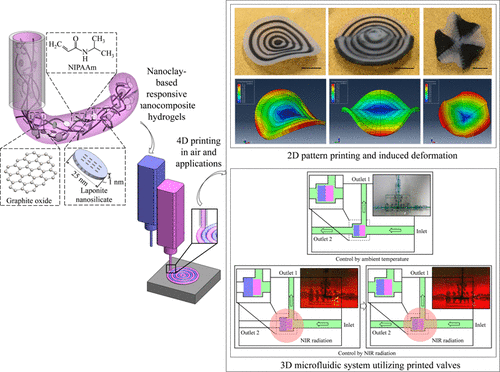当前位置:
X-MOL 学术
›
ACS Appl. Mater. Interfaces
›
论文详情
Our official English website, www.x-mol.net, welcomes your feedback! (Note: you will need to create a separate account there.)
Nanoclay-Based Self-Supporting Responsive Nanocomposite Hydrogels for Printing Applications
ACS Applied Materials & Interfaces ( IF 9.5 ) Pub Date : 2018-03-01 00:00:00 , DOI: 10.1021/acsami.8b00806 Yifei Jin , Yangyang Shen , Jun Yin , Jin Qian , Yong Huang
ACS Applied Materials & Interfaces ( IF 9.5 ) Pub Date : 2018-03-01 00:00:00 , DOI: 10.1021/acsami.8b00806 Yifei Jin , Yangyang Shen , Jun Yin , Jin Qian , Yong Huang

|
Stimuli-responsive hydrogels and/or composite hydrogels have been of great interest for various printing applications including four-dimensional printing. Although various responsive hydrogels and/or composite hydrogels have been found to respond to given stimuli and change shapes as designed, the fabrication of three-dimensional (3D) structures from such responsive hydrogels is still a challenge due to their poor 3D printability, and most of the responsive material-based patterns are two-dimensional (2D) in nature. In this study, Laponite nanoclay is studied as an effective additive to improve the self-supporting printability of N-isopropylacrylamide (NIPAAm), a thermoresponsive hydrogel precursor while keeping the responsive functionality of NIPAAm. Graphene oxide (GO) is further added as a nanoscale heater, responding to near-infrared radiation. Due to the different shrinking ratios and mechanical properties of the poly(N-isopropylacrylamide) (pNIPAAm)–Laponite and pNIPAAm–Laponite–GO nanocomposite hydrogels, printed 2D patterns deform in a predictable way. In addition, 3D microfluidic valves are directly printed and cured in air, which can effectively control the flow directions in response to different stimuli as validated in a microfluidic system. Because Laponite nanoclay can be mixed with various responsive hydrogel precursors to improve their 3D printability, the proposed Laponite nanoclay-based nanocomposite hydrogels can be further expanded to prepare various 3D printable responsive nanocomposite hydrogels.
中文翻译:

用于印刷应用的基于纳米粘土的自支撑响应性纳米复合水凝胶
刺激响应性水凝胶和/或复合水凝胶对于包括二维印刷在内的各种印刷应用都引起了极大的兴趣。尽管已发现各种响应性水凝胶和/或复合水凝胶可以响应给定的刺激并按设计改变形状,但是由于此类响应性水凝胶的3D可印刷性差,并且大多数情况下,它们仍需制造三维(3D)结构本质上,基于响应材料的模式是二维(2D)。在这项研究中,Laponite纳米粘土被作为一种有效的添加剂来改善N的自承印性-异丙基丙烯酰胺(NIPAAm),一种热响应性水凝胶前体,同时保持NIPAAm的响应性功能。进一步添加氧化石墨烯(GO)作为纳米级加热器,以响应近红外辐射。由于聚(N-异丙基丙烯酰胺)(pNIPAAm)–皂石和pNIPAAm –皂石– GO纳米复合水凝胶,印刷的2D图案以可预测的方式变形。此外,直接在空气中打印和固化3D微流体阀,可以响应微流体系统中验证的不同刺激有效地控制流向。由于可以将Laponite纳米粘土与各种响应性水凝胶前体混合以提高其3D可印刷性,因此可以进一步扩展提出的基于Laponite纳米粘土的纳米复合水凝胶,以制备各种3D可打印的响应性纳米复合水凝胶。
更新日期:2018-03-01
中文翻译:

用于印刷应用的基于纳米粘土的自支撑响应性纳米复合水凝胶
刺激响应性水凝胶和/或复合水凝胶对于包括二维印刷在内的各种印刷应用都引起了极大的兴趣。尽管已发现各种响应性水凝胶和/或复合水凝胶可以响应给定的刺激并按设计改变形状,但是由于此类响应性水凝胶的3D可印刷性差,并且大多数情况下,它们仍需制造三维(3D)结构本质上,基于响应材料的模式是二维(2D)。在这项研究中,Laponite纳米粘土被作为一种有效的添加剂来改善N的自承印性-异丙基丙烯酰胺(NIPAAm),一种热响应性水凝胶前体,同时保持NIPAAm的响应性功能。进一步添加氧化石墨烯(GO)作为纳米级加热器,以响应近红外辐射。由于聚(N-异丙基丙烯酰胺)(pNIPAAm)–皂石和pNIPAAm –皂石– GO纳米复合水凝胶,印刷的2D图案以可预测的方式变形。此外,直接在空气中打印和固化3D微流体阀,可以响应微流体系统中验证的不同刺激有效地控制流向。由于可以将Laponite纳米粘土与各种响应性水凝胶前体混合以提高其3D可印刷性,因此可以进一步扩展提出的基于Laponite纳米粘土的纳米复合水凝胶,以制备各种3D可打印的响应性纳米复合水凝胶。



























 京公网安备 11010802027423号
京公网安备 11010802027423号